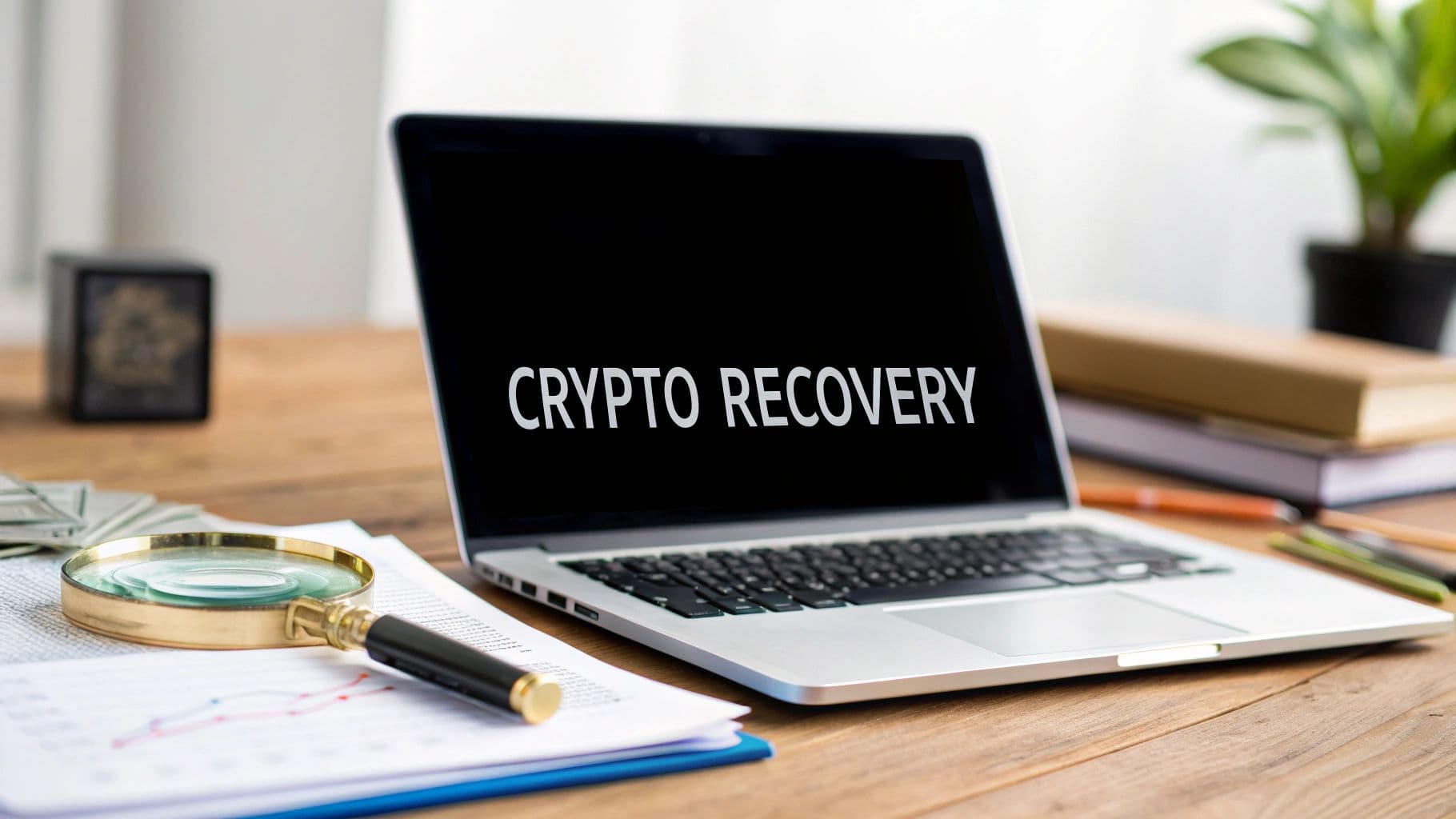
Crypto Scam Recovery A Practical Guide
The key to recovering from a crypto scam is moving quickly. You need to secure what's left, document every single detail, and get the incident on the radar of the right authorities. It’s a tough situation, but taking immediate action drastically improves your odds of a good outcome.
Your First Moves After a Crypto Scam
That sinking feeling when you realize you've been scammed is overwhelming. But what you do in the next few hours is absolutely critical. Panic is your enemy; a clear, methodical approach is your best weapon. Think of this as immediate damage control—your chance to lay the foundation for a potential recovery.
First things first: stop the bleeding.
If the scam involved a compromised wallet, or worse, you gave a scammer remote access to your computer, containment is your only priority. Immediately transfer any remaining crypto from the affected wallet to a brand new, secure wallet that only you control. For a more structured approach, it's worth understanding the principles of building an effective security incident response plan, as the same logic applies here.
To help you focus during this high-stress time, here’s a quick-reference checklist of the first five things you absolutely must do.
Immediate Actions After a Crypto Scam
| Action Step | Why It's Critical |
|---|---|
| 1. Isolate the Compromised Wallet | Stop any further unauthorized transactions. Move all remaining funds to a new, secure wallet immediately. |
| 2. Secure Your Devices | Disconnect the compromised device from the internet. Run antivirus/antimalware scans to check for keyloggers or other malicious software. |
| 3. Change All Related Passwords | Update passwords for your crypto exchange accounts, email, and any other accounts linked to the compromised wallet or device. |
| 4. Preserve All Evidence | Take screenshots of everything: chat logs, emails, scam websites, and transaction IDs (hashes). Do not delete anything. |
| 5. Report to Exchanges/Wallets | Contact the support teams of any exchanges or wallet providers involved to report the fraudulent addresses. They may be able to freeze funds. |
Following these steps methodically will help you regain control and build a solid base for the next phase of your recovery effort.
Understanding What Happened
With the immediate threat contained, you need to piece together how the scammer operated. Identifying the specific type of scam you fell victim to is crucial—it helps frame the entire recovery process and sets realistic expectations from the get-go.
For instance, did a sophisticated phishing attack trick you into giving up your private keys? Or were you lured into a fake investment platform that showed amazing returns right before vanishing with your money?
Common scams I see all the time include:
- Phishing Scams: These are fraudulent websites or emails that look incredibly legitimate, all designed to steal your login credentials or, even worse, your seed phrase.
- Fake Investment Platforms: Scammers build elaborate, professional-looking websites that promise guaranteed high returns. Once you deposit funds, they're locked, and you're hit with endless demands for more "taxes" or "fees" to withdraw.
- Impersonation Scams: This is where someone poses as a support agent, a celebrity, or even a government official to earn your trust and get access to your assets.
This flow chart breaks down the foundational steps: Secure, Document, and Report.
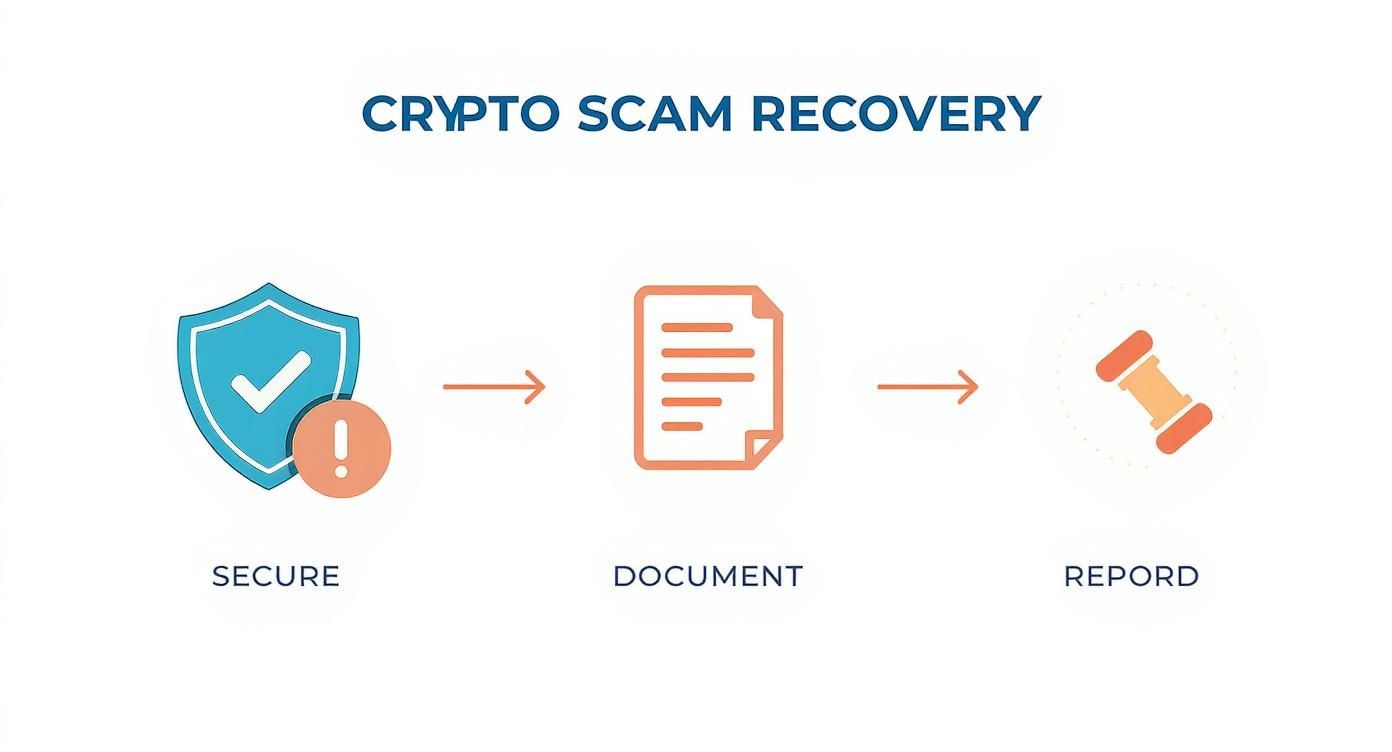
Sticking to this sequence ensures you first protect what you have left, then you can focus on building the evidence needed for official action.
The Financial Reality and Hope for Recovery
Let's be blunt: the scale of crypto crime is massive. In the first half of 2025 alone, more than $3.1 billion was stolen globally through crypto scams and hacks. Projections show that figure could climb past $4.3 billion by the end of the year.
But don't let those numbers discourage you. There's a promising side to this story. In 2024, reputable industry recovery firms reported success rates between 94% and 98%.
The most crucial thing to remember is that while recovery is never guaranteed, it is far from impossible. Success almost always comes down to swift action, meticulous documentation, and getting the right help—whether from law enforcement or specialized recovery services.
By arming yourself with a clear understanding of the specific scam you're dealing with, you can move forward with a solid strategy. This initial groundwork sets the stage for everything that comes next in the investigation and recovery process.
Building Your Evidence Case File
In the chaotic moments after you realize you've been scammed, the single most powerful thing you can do is get organized. Any real chance at crypto scam recovery is built on a solid foundation of evidence. You need to become the lead detective on your own case, and your first job is to meticulously gather every digital breadcrumb that tells the story of what happened.
This isn't about becoming a blockchain forensics expert overnight. It's about putting together a clean, comprehensive case file that you can hand over to law enforcement, exchanges, and any recovery specialists you work with.
Your first move? Capture every single interaction you had with the scammer. Don't trust your memory or assume those chat logs will be there tomorrow.
- Screenshot Everything: I mean everything. Take clear, full-screen captures of your chats on Telegram, WhatsApp, Discord, or wherever the conversation happened. Do the same for emails, social media DMs, and any part of the scam website that shows their promises or instructions.
- Archive URLs: Save the web addresses of the fake investment platform, phony exchange, or phishing site. These sites often disappear quickly, but having the original URL is a critical piece of the puzzle for investigators.
- Document Profiles: Grab screenshots of the scammer's social media profiles, usernames, and any scraps of personal information they shared. It might all be fake, but you never know what detail might crack the case open.
Tracing the Initial Transaction
Okay, now it's time to follow the money. This part sounds technical, but the first steps are surprisingly straightforward. Your goal is to find the most important piece of evidence in this entire process: the transaction ID (TXID), also known as a transaction hash. Think of it as the public receipt for your transfer, etched permanently onto the blockchain.
You'll use a public blockchain explorer for this. For anything on the Ethereum network (like ETH, USDC, or thousands of other tokens), you’ll use a site like Etherscan. For Bitcoin, Blockchain.com's explorer is a popular choice. It's a common myth that crypto is totally anonymous; these public ledgers are actually more transparent than people think. If you want to go deeper, you can learn more about how Bitcoin's anonymity works in our detailed article.
Here’s an example of what you’re looking for on Etherscan:
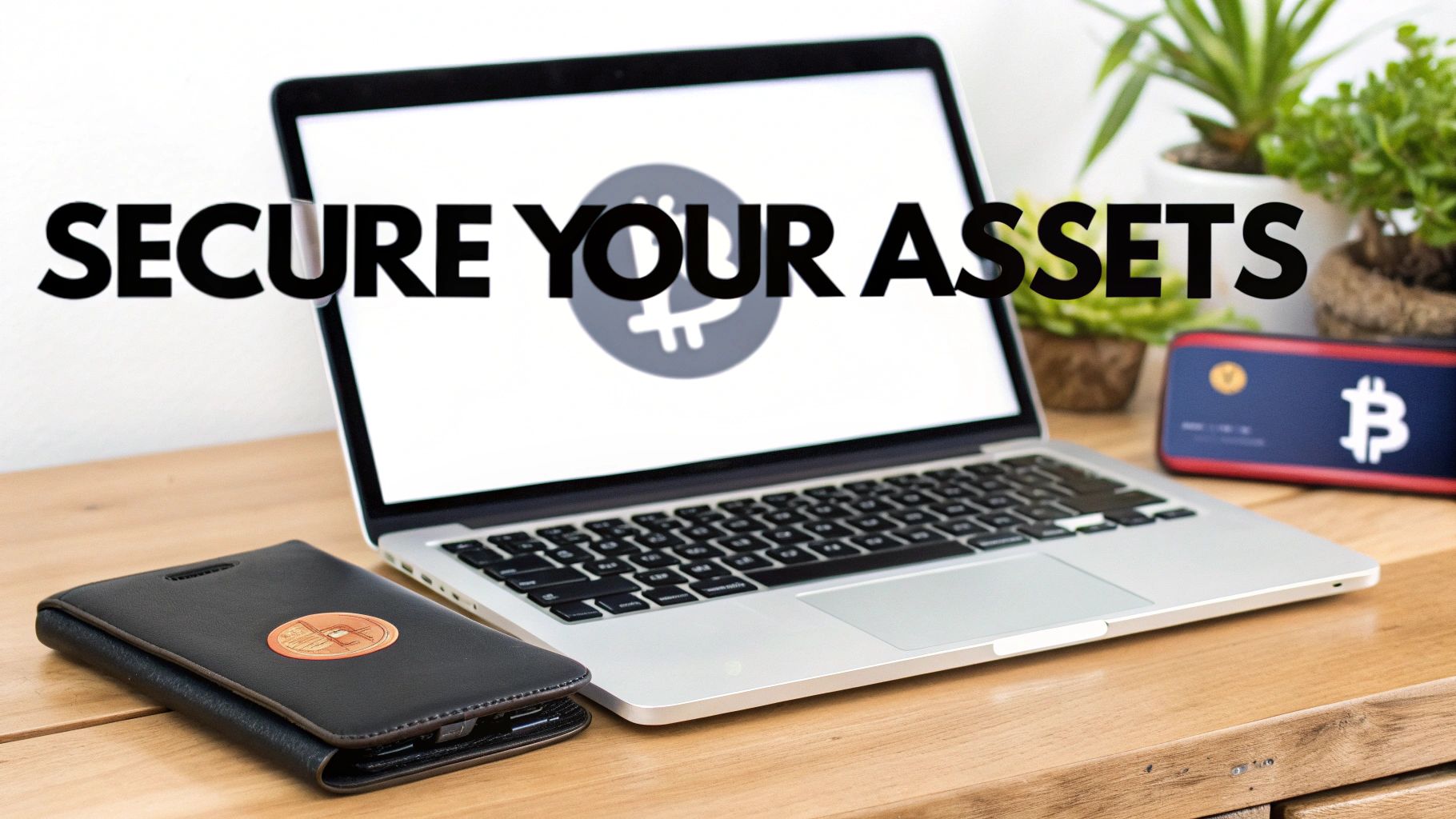
This single screen gives you the "From" address (yours), the "To" address (the scammer's), the exact amount, and that all-important transaction hash. This is gold.
Your main task here is creating a simple log. Open a spreadsheet and record every single transaction hash, the amount, the date, and the scammer's wallet address. This organized data is absolutely invaluable.
Consolidating Your Evidence
Finally, pull all of these digital clues together into a single, organized folder on your computer. This file is now your master evidence package. It should have every screenshot, URL, transaction ID, and any notes you took about the timeline of events.
When you start reporting the crime, this case file is your best friend. It shows you're serious and organized, making it infinitely easier for the authorities or a recovery firm to grasp the situation and get to work. Trust me, taking the time to do this prep work is a non-negotiable first step that can dramatically increase your chances of a positive outcome.
Reporting the Scam to the Right People
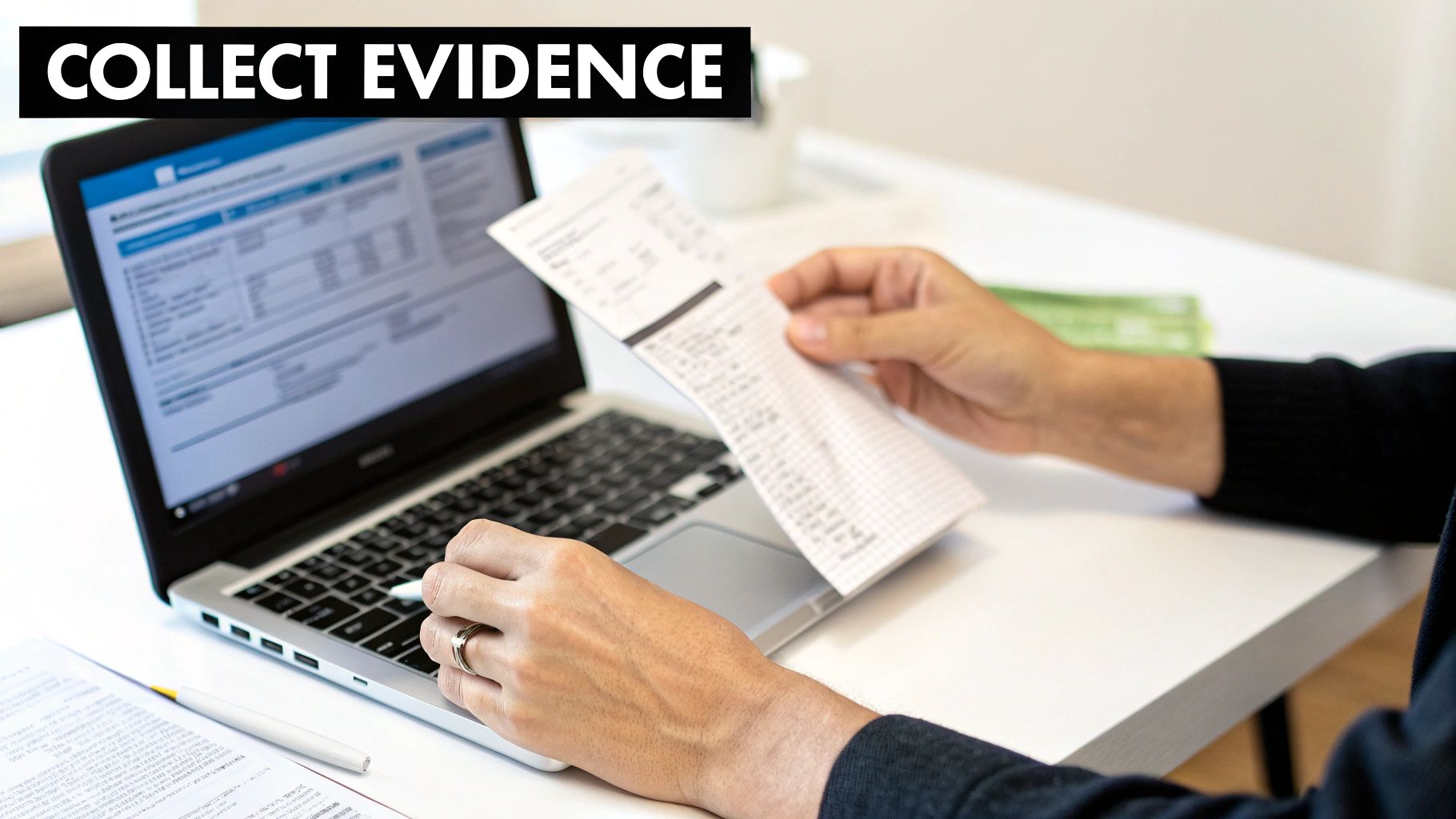
After you've been scammed, taking it to the authorities can feel like a daunting step, but it's absolutely crucial. This isn't just about creating a paper trail for your own case; it's about giving law enforcement the ammunition they need to spot patterns and take down entire criminal rings. Your report might just be the one that connects the dots on a much bigger operation.
A lot of people I've worked with ask if it's even worth the bother. My answer is always a firm yes. While there’s no guarantee it will get your money back tomorrow, filing an official report formalizes the crime. This is often a non-negotiable first step if you plan to bring in legal help or certain recovery services later on.
Who to Contact and Where to Start
Figuring out which agency to call first can be confusing. For crypto scams, especially if you're based in the U.S., a few key organizations should be on your list. Each one looks at the crime from a different angle, so reporting to all of them gives you the best coverage.
Here’s where you should focus your efforts:
- The FBI's Internet Crime Complaint Center (IC3): This is your primary stop. The IC3 is the FBI's main portal for cybercrime, and their forms are built to handle exactly these kinds of incidents. Be as detailed as you can and upload all the evidence you’ve gathered.
- The Federal Trade Commission (FTC): Think of the FTC as the nation's fraud watchdog. Reporting to the FTC helps them identify emerging scam tactics, issue public alerts, and build a massive database that law enforcement agencies use to track criminals.
- Your Local Police Department: Don't skip this one. Even if your local cops aren't blockchain experts, getting a police report number is a huge deal. It provides an official, local record of the theft, which can be essential for things like insurance claims or other legal actions down the road.
What to Put in Your Official Report
When you're filling out those forms, details are everything. This is where that case file you put together earlier really shines. Don't just write "I lost some crypto." You need to give them a story they can actually investigate.
Make sure your report includes these key elements:
- A Detailed Timeline: Walk them through it from the beginning. When did the scammer first contact you? When were the transactions made? Note every date and time you can.
- Scammer Details: Hand over everything you have on them. This includes usernames, email addresses, social media links, phone numbers, and any websites they used.
- The Blockchain Trail: List every single transaction hash (TXID), the scammer’s wallet addresses, and the exact amounts of crypto that were sent.
- Your Evidence File: This is crucial. Upload all your screenshots of conversations, fake websites, and anything else you collected.
Remember, filing these reports is about more than just your own situation. You’re contributing to a broader fight. Every piece of data—every wallet address, every scammer tactic—helps authorities build a better defense and stop these criminals from hitting their next target.
Once you’ve submitted everything, save copies of each report and any confirmation numbers you get. This documentation is your official proof of the crime and sets you up perfectly for the next phase of your recovery effort.
Working with Professional Recovery Services
When you've filed official reports and feel like your evidence has vanished into a black hole, turning to a specialized crypto recovery service can feel like your next best move. These firms live in the space between deep blockchain forensics and legal action, offering a more hands-on approach to chasing down stolen funds.
But here’s the reality: this is an unregulated field. For every genuine expert, there's a predator looking to scam the already-scammed. You have to tread very, very carefully.
A legitimate firm has a clear, methodical process. They won't just take your case and go dark. They use powerful blockchain analysis tools to follow the digital breadcrumbs your stolen crypto leaves behind as it's funneled through mixers, tumblers, and countless wallets. Their entire value is in their ability to untangle that complex web and de-anonymize the thieves.
Vetting a Crypto Recovery Specialist
Your first and most important job is to tell the difference between a real expert and a recovery scammer. Sadly, a huge chunk of the "crypto recovery" industry is built on fraud.
Keep an eye out for these non-negotiable red flags:
- Guaranteed Returns: Nobody can guarantee they'll get your stolen crypto back. Anyone promising a 100% success rate is simply not telling you the truth. A real professional will be upfront about the challenges and the slim odds.
- Large Upfront Fees: Reputable companies usually work on a contingency basis (they take a cut of what's recovered) or charge a small, reasonable fee for an initial assessment. If they demand thousands of dollars upfront—especially in crypto—it’s a massive warning sign.
- Cold Solicitations: Did a "recovery expert" suddenly appear in your DMs right after you posted about being scammed on social media? Run. These are almost always opportunistic predators.
A legitimate firm, for example, will start with a feasibility study. They'll look at your evidence, trace the first few transactions, and give you an honest, realistic assessment of your chances before you commit to anything significant.
What Success Actually Looks Like
Even when you hire a legitimate service, a successful recovery rarely means your stolen crypto just reappears in your wallet one day. The real goal is often to trace the funds to a centralized exchange—a place where the scammer has to reveal their identity to cash out.
A reputable recovery service acts as a bridge. They do the heavy lifting on the forensic side and then hand law enforcement a detailed report. This report connects the on-chain data (like transaction hashes) to off-chain identities (like exchange accounts), giving authorities the actionable intelligence they need to issue subpoenas or freeze assets.
While staggering sums are lost to crypto fraud each year—projected to top $12 billion globally in 2025—recovery efforts are getting smarter. Law enforcement and forensic investigators are now armed with advanced blockchain analytics to track stolen assets, and recovery rates are slowly improving. It's this teamwork between private firms and public agencies that's making a difference.
We're also seeing legal avenues open up for victims of larger-scale failures; for instance, FTX investors may be able to pursue recovery of investment losses through class-action lawsuits.
Ultimately, partnering with a professional can give your efforts a major boost, but only if you do your homework first. For a more detailed breakdown of the entire process, our guide on how to recover lost or stolen cryptocurrency is another great resource to have in your back pocket.
Protecting Your Assets from Future Scams
Getting your crypto back after a scam is a tough, draining experience. Once you're through it, the goal isn't just to recover—it's to make sure you never have to go through it again. Now is the time to fortify your defenses and become a much harder target for criminals.
It all starts with a simple idea: your digital assets need physical protection. If you're serious about crypto, a hardware wallet isn't optional, it's essential. Software wallets are always online, leaving them open to malware and hacks. A hardware wallet, on the other hand, keeps your private keys completely offline.
Think of it as a physical vault for your crypto. Every transaction has to be manually approved on the device itself, which means a hacker on the other side of the world can't just drain your funds. To really get into the nuts and bolts, take a look at our guide on what is a hardware wallet and how does it work.
Recognizing the Scammer’s Playbook
Beyond the tech, your best defense is a healthy dose of skepticism. Scammers are experts at playing on human emotions like greed and fear, not just exploiting code. They rush you into making bad decisions before you have time to think.
Keep an eye out for these classic red flags:
- Manufactured Urgency: You'll see phrases like, "This deal is gone in an hour!" or "Act now or your account will be frozen!" It's a trick designed to make you panic and skip your usual due diligence.
- Guaranteed High Returns: Real investments come with risk. Period. Anyone promising guaranteed profits with no downside is trying to scam you. It's a universal truth in finance.
- Impersonation Scams: Scammers will pretend to be anyone—a support agent, a government official, or an employee from a company you trust. Always confirm their identity by going directly to the official website or app, never by clicking a link they sent you.
The reality is that attacks on individuals are getting more common and more sophisticated. Hackers are hitting crypto platforms harder than ever. In the first quarter of 2025 alone, a staggering $1.63 billion was stolen, which is a 131% jump from the year before. Phishing and attacks on personal wallets now make up almost a quarter of that total. You can find more crypto exchange security statistics on sqmagazine.co.uk.
The Unbreakable Rules of Crypto Security
Finally, you need to burn a few golden rules into your brain. These are the non-negotiable principles of self-custody that will shield you from the vast majority of scams out there.
Never, ever share your private keys or seed phrase. I don't care who asks—a support agent, a developer, even the CEO of the company. There is zero legitimate reason for anyone to need this information. Your seed phrase is the master key to your entire crypto portfolio.
Treat that phrase like the most important secret you'll ever keep. Write it down on paper, maybe even laminate it, and store it in a few secure, physical spots. Never, under any circumstances, type it into a website or save it on a computer or phone. This disciplined mindset is your ultimate protection against future threats.
Answering Your Crypto Recovery Questions
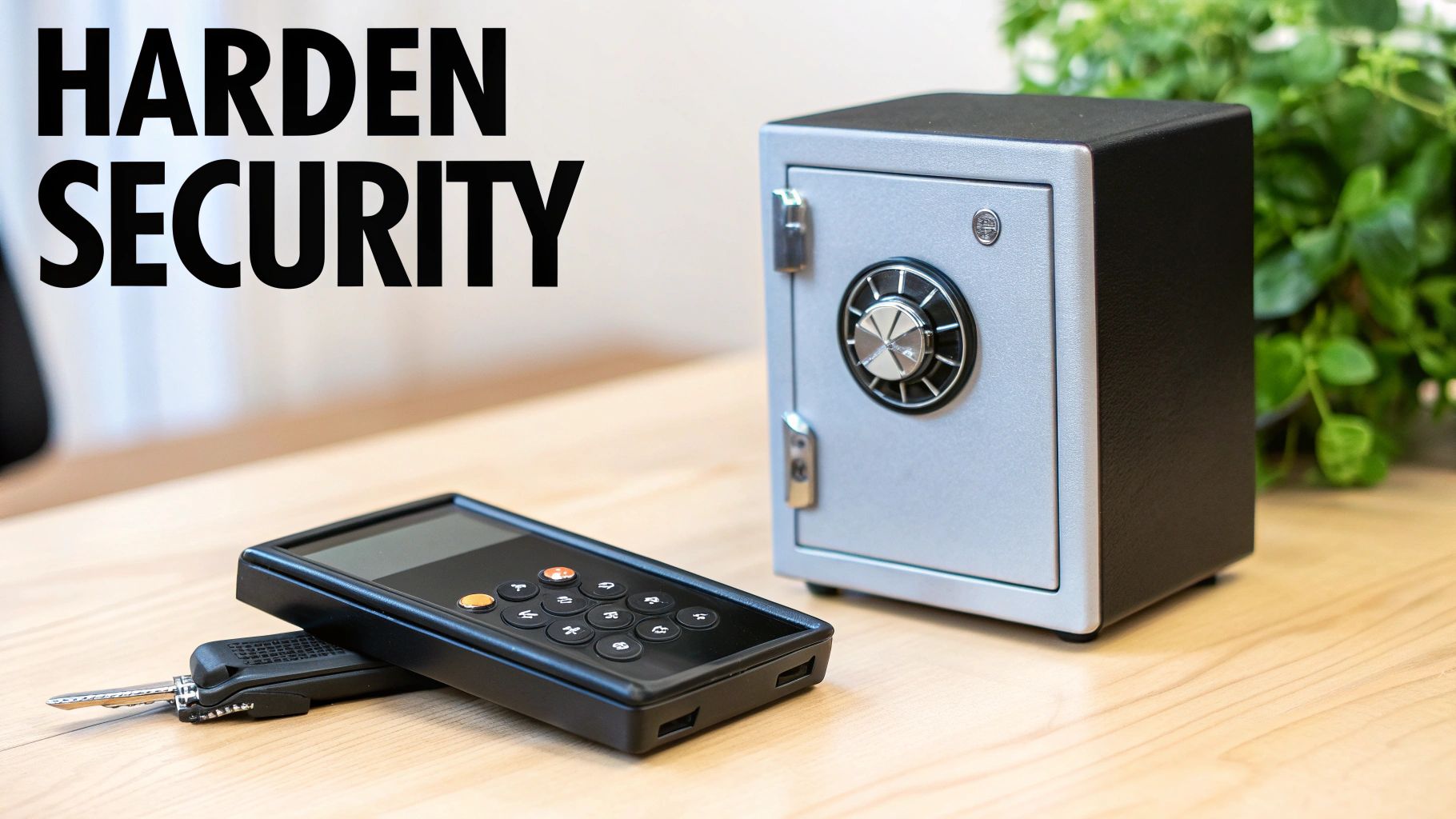
When you're reeling from a crypto scam, your mind is probably racing with urgent questions. After you’ve filed reports and maybe even reached out for help, a lot of uncertainty can still hang in the air. Let's tackle some of the most common questions I hear from victims to give you a clearer picture of the road ahead.
One of the first things everyone wants to know is, "Is my crypto gone for good?" The honest answer is... it depends. While recovery is always a long shot, it's not impossible. Your chances really hinge on speed and where the scammer sends the funds. If they move the stolen crypto to a major, regulated exchange to cash out, there's a small but real window where law enforcement can intervene and freeze the account.
This brings up another big question: How long does this all take? Brace yourself, because there's no quick fix here. The recovery process can be painfully slow, often stretching out for months or even years. We're talking about a complex web of different jurisdictions, coordinating with law enforcement, and navigating a ton of legal red tape. Patience isn't just a virtue here; it's a necessity.
Can I Get My Money Back Through Legal Action?
Naturally, many victims think about suing the scammer. The biggest wall you'll hit is figuring out who to sue. A wallet address is just a string of characters; linking it to a real person is the true challenge. Scammers are pros at using mixers and privacy coins to obscure their tracks, but they sometimes slip up.
Still, legal action isn't off the table, particularly if the scam involved a large-scale fraudulent investment platform or an organized criminal ring. When authorities manage to identify and prosecute these groups, courts can order them to pay restitution to their victims. This is a long-term game, but it’s a powerful reason why filing that police report is so crucial—it officially documents you as a victim who is owed money.
The bottom line is this: while you can pursue a civil lawsuit, it's often expensive and depends entirely on identifying the thief first. The criminal prosecution route, kicked off by your official reports, is frequently the more realistic (though slower) path to potentially getting some money back.
What Are the Tax Implications of a Crypto Scam?
Losing your crypto is bad enough. The thought of dealing with taxes on top of it just adds insult to injury. A common question I get is whether you can write off the loss on your taxes for some financial relief. It’s a tricky area that really depends on where you live and the specifics of the scam.
In the U.S., for instance, the rules around deducting theft losses for individuals got much tighter after 2018. Generally, you can only deduct a loss if it came from a transaction you entered into for profit—like a fake investment that went south. If you lost funds in a personal scam, like a romance scam, you're usually out of luck on the tax front.
Here are a few things to keep in mind:
- Was it an "investment?" If the scam was framed as an investment opportunity, you have a much stronger argument for claiming a theft loss deduction.
- Timing is key. You have to claim the deduction in the year you discover the theft, not necessarily when it happened. You also can't claim it if there's still a reasonable chance you might get your money back.
- Talk to a pro. Tax law is a minefield. You absolutely need to speak with a qualified tax professional who actually understands cryptocurrency. They can look at your specific case and give you real advice.
Getting answers to these questions is a big part of moving forward. The path is tough, no doubt about it, but knowing the realities of the process helps you set the right expectations and make better decisions.
Ready to secure your business's crypto transactions and avoid the pitfalls of payment processing? BlockBee offers a non-custodial gateway that keeps you in full control of your funds. Learn more and get started at https://blockbee.io.
